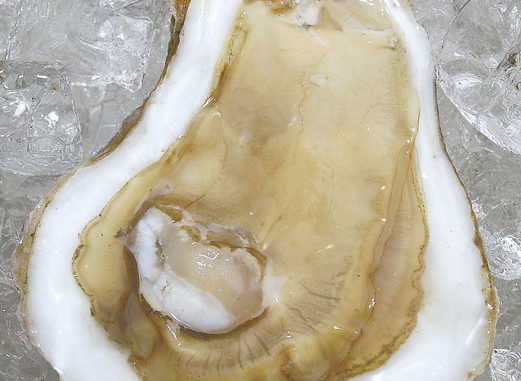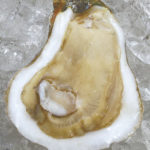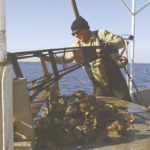
Is Our Seafood Safe?
Defining toxicity is tricky because much depends on the method of delivery, the dose and a personal interpretation of the word “toxic.” Cabbage, broccoli, Brussels sprouts and anything soy are toxic because they contain goitrogen. Salt can be a powerful toxin. Ethyl alcohol, the stuff in beer, wine and whiskey, is toxic (as well as being metabolizabled as a food).
Oil in the BP oil spill has been universally described as an almost deadly toxin, almost one that kills on contact.
But what is the truth?
“In general, hydrocarbons have a low degree of toxicity to humans,” says Dr. LuAnn White, a toxicologist with the Tulane University School of Public Health and Tropical Medicine, Director of the Center for Applied Environmental Health and a diplomat of the American Board of Toxicology. “That means that it takes a large amount to cause adverse effects. The most common symptoms are irritation, headache and nausea, and the symptoms get better when removed from exposure.”
White explains that when people think of oil and toxicity, they often think of what they are familiar with, the sight of oiled pelicans. But Pelicans are not killed by the toxicity of oil. Rather, oil coats the birds’ feathers, reducing their ability to fly, eat or drink. They get dehydrated and starve to death.
“It works the same way with fish,” she says.
White feels that people have confused the compounds of most concern in oil, the polycyclic aromatic hydrocarbons (PAHs), with chemicals such as DDT and mercury that bioaccumulate over time. PAHs are metabolized, but sometimes the metabolic process produces free radicals, subatomic particles that are only around milliseconds but can do genetic damage and potentially cause cancer.
Finding PAHs in fish is extremely rare.
The National Oceanic and Atmospheric Administration (NOAA), in their publication Managing Seafood Safety After an Oil Spill, explains that finfish, like other vertebrates including humans, have mixed-function oxygenase enzyme systems that biotransform, metabolize and excrete PAHs into bile. Crustaceans, such as crabs and shrimp, have a more limited capacity to do the same, and mollusks such as oysters have the least. Still, maintains White, PAH levels in oysters will come down in a matter of weeks after the source of oil is removed.
Finfish, and to a lesser degree shrimp and crabs, also have the ability to leave an area of oil concentration and reduce their exposure to it.
White, Dr. Ralph Portier, a professor of Environmental Science with the Louisiana State University Department of Environmental Sciences and the School of the Coast and the Environment, and Dr. Ed Overton, an environmental chemist and Professor Emeritus, also with the LSU Department of Environmental Sciences, agree that the most toxic element of oil, the PAHs, will be consumed by microorganisms and eliminated from the environment, “the ultimate solution,” as White calls it.
Portier described bacterial action with relish.
“They will start chewing away right away, the light stuff first, then the heavy stuff,” he said.
He called oil dissolved in water “great bug food.” The heaviest components are eaten last and often end up sinking to the bottom of the deep ocean. These are the least-toxic components of oil, and while it may take decades, other bacteria will consume them in the cold, low-oxygen environment.
The oil does enter the food chain, but not in the way that people fear. It is turned into carbon dioxide, water and biomass — the bodies of bacteria that will be eaten by other creatures.
Overton agrees. The increased numbers of bacteria either end up dying and sinking to the bottom or creating a feast for zooplankters, which are in turn eaten by higher predators.
Once the oil is degraded, he says, it is no longer oil. It is biomass. It is the body of whatever it is at the time. When we eat steak, the steak turns into us — we don’t turn into the steak. The same thing happens with oil and bacteria. Two-thirds of the oil turns into carbon dioxide and one-third into biomass.
The supposed toxicity of dispersants has become more hotly debated than that of crude oil. A May 14, 2010, U.S. Food and Drug Admistration memorandum from Dr. Kiros Hailemariam to Supervisory CSO (Compliance Director) Peter Koufopouolos stated, “Though early dispersants contained agents highly toxic to marine life, manufacturers have refined formulations of more recent generations of dispersants to dramatically reduce toxicity.”
The memorandum noted that monitoring following a 1997 oil spill incident in England “demonstrated that the use of dispersants resulted in a net environmental benefit and that the potential toxic effects of the dispersant application are due to the enhanced volumes of dispersed oil and not from the dispersant itself.”
It cited a report that suggested that dispersant use increased the rate of biodegradation by promoting the growth of native oil-eating bacteria as well as increasing the surface area of oil subject to bacterial attack.
“In conclusion, the available information indicates that dispersants have little or no effect on the bioaccumulation of oil contaminants, nor do they themselves accumulate in seafood.”
In response to intense interest about the toxicity potential of dispersants, the U.S. Environmental Protection Agency conducted toxicity tests on eight brands of dispersants, including Corexit 9500. On June 30, EPA released the results of Phase I testing. None of the dispersants tested showed endocrine-disrupting activity, an early concern. The dispersant products alone, not mixed with oil, were roughly equal in effects on aquatic life, which should have, but didn’t, dispel the rumor that Corexit was more toxic than other brands available.
The results of Phase II testing were announced on Aug. 2. The results reconfirmed that the Corexit used in the Gulf was generally no more or less toxic than other alternatives. The eight dispersants were then tested in combination with Louisiana sweet crude oil. The results showed that the dispersants alone were less toxic than the dispersant/oil mixture.
On its web site, updated Nov. 17, FDA posted that the dispersants used in the Gulf are not likely to build up in the flesh of fish: “This is primarily based on the assessment of their physical properties, which indicate that these compounds do not penetrate the gills or bodies of fish, and will not be consumed in edible tissues of seafood.”
Overton dispelled another widespread myth, that the U.S. used a dispersant that is banned in England.
“Corexit is licensed in Europe, including England, for offshore applications — just like in the U.S.,” he said.
A final note was added by Dr. Robert Dickey, director of FDA’s Gulf Coast Seafood Laboratory.
“There has been a big misunderstanding of the nature of dispersants,” he said. “In fact, they are not very toxic. They are detergents and solvents. And they become rapidly diluted. Take into consideration the volume of water. One square mile of sea water one foot deep is 200 million gallons. We added 1.8 million gallons in the whole Gulf — a little bit of perspective.”
So what about the testing?
According to Olivia Watkins, executive media advisor for the Louisiana Department of Wildlife and Fisheries, testing of fish and seafood in response to the spill began before areas were closed to fishing. Early testing was done to establish baseline level — what could be found in fish and seafood before it was impacted by the spill.
At the state level, samples were made weekly by LDWF from each of their seven coastal study areas and sent to independent labs. The Louisiana Department of Health and Hospitals sampled the state’s 30 oyster harvest areas as well. Watkins said that a number of these were sent to FDA for testing, but most went to independent labs.
Samples to be tested for dispersants were also taken and sent to federal agencies.
“Not a single sample [for oil or dispersant] has come anywhere close to levels of concern,” Watkins said.
LDHH’s Dr. Jimmy Guidry, the Louisiana State Health Officer and medical director for the agency, corroborated Watkins’ statement. Of the 1,073 fish and seafood samples taken since April 30, 507 had no PAHs detected, 654 had trace amounts and no samples had PAHs over levels of concern.
Guidry noted that aliphatic hydrocarbons, the non-PAH component of crude oil, showed up as a zero in all samples. Finally, he drew attention to the fact that the samples taken by his agency and LDWF were all composites. For example, a single shrimp sample would have approximately 100 different individual shrimp in the sample. This vastly increased the number of animals sampled.
Testing of seafood was a two-pronged effort. One prong was at the state level. The other was federal, the major players of which were NOAA, the federal fisheries manager, and FDA, with the responsibilities of food safety and regulation of interstate commerce of seafood. EPA played a peripheral, but important, role.
Dickey, director of FDA’s Gulf Coast Seafood Laboratory, says that federal preparations began within days of the spill, as they had been through this before in other states.
The first step was for NOAA to close to fishing waters that had been impacted or were expected to be impacted. Then they visited primary seafood processors to make sure that their HACCP (hazard analysis and critical control point) plans were in place. Processors were instructed not to handle seafood from closed waters.
Then sampling began. The early sampling was to gather baseline data. Sampling shifted to sampling areas for the possibility of re-opening them to fishing and stayed there, an important point to remember.
A sampling and reopening protocol was developed with FDA’s sister agencies. Dr. Calvin Walker, a toxicologist by training and the lead analyst for the NOAA National Seafood Inspection Laboratory in Pascagoula, Miss., described the protocol as involving three steps.
First, the area from which the seafood was to be tested had to be clear of any sign of oil, even light sheens. If oil sign was present, the seafood was assumed to be exposed and wasn’t even considered for testing.
Once an area was deemed clear of visible oil for a period of time, samples would be accepted from state agencies or gathered by NOAA boats or contractors. Samples taken by state agencies were processed and sent to FDA, which tested the samples in their labs or those of cooperating state labs. The first federal samples were sent to the NOAA Northwest Fisheries Science Center in Seattle for testing. Later they were tested in Pascagoula.
Walker explained that the samples were processed for testing by using the edible portion of the seafood. For fish, with the exception of menhaden and butterfish, which were tested whole, only the flesh was used. For oysters, both the flesh and liquor were tested. Both tail meat as well as the vein were tested in shrimp.
The portion to be tested was finely ground into a slurry. Then a panel of seven highly trained “assessors,” professional sniffers and tasters, smelled the product. Five out of seven had to agree that the seafood had no taint. Then it was microwaved and smelled again. If it passed that step, then it was tasted. At each step, five of the seven assessors had to pass the product.
If a sample passed the sensory hurdles, it would be analyzed in a laboratory with a gas chromatograph-mass spectrometer and a liquid chromatograph-florescence detector. Only if the samples were below the “level of concern,” was an area considered for reopening to fishing. The level of concern was one chance in 100,000 that a person who consumes more seafood than 90 percent of the public would develop cancer.
Sensory detection, as well as lab testing, was and is also used to detect dispersants.
“They smell like detergents,” Walker said, “which is what they are.
“Dispersants, from a public health standpoint, are of very low concern because they don’t bioaccumulate; they are readily dispersed and diluted, are very water soluble and highly biodegradable. But early on, they were an unknown. And things unknown are concerning to people.”
Walker says that more than 8,000 seafood samples have been tested by federal agencies since the spill began, and not one has come in over the level of concern.
“In my opinion,” he said, “the seafood in the Gulf is extremely and extraordinarily safe. I eat it routinely, and I feed it to my grandchildren. The seafood captured from reopened areas in the Gulf of Mexico is the most tested seafood in the world.”
Tulane University’s White said she felt that people don’t understand the sampling program. Some scientists, she said, go looking for oil and test seafood in oiled areas where it is likely to be oiled.
Their results shouldn’t be surprising and shouldn’t be compared to the sampling done under the monitoring protocol. That doesn’t mean that government biologists can’t find oil in seafood, but rather that under the sampling protocol used to reopen areas, they don’t test seafood from oiled areas that are obviously not clean enough to re-open.
Another problem seems to be distrust of the effectiveness of sensory analyses of seafood.
“The press has made a big thing of the smell test,” says marine microbiologist and toxicologist Portier. “But that’s actually a pretty good test.”
Dr. John Bell, professor in the LSU Department of Food Science, wholeheartedly agreed with Portier.
“Human taste buds can detect petroleum components at the parts per million level, and the sense of smell can detect PAH volatiles to the parts per billion level,” he said. “You’re going to know it before it hits your mouth. Petroleum is not like heavy metals, antibiotics or pesticides.
“I am confident that the system will keep out seafood that has been impacted by the BP spill.”
Understanding risk
Risk is hard to define in relative terms, and even more difficult in absolute terms. Essentially, a risk is best understood relative to other known risks.
“It is difficult for consumers to understand health risks in seafood,” Bell said. “PAHs are found elsewhere. When we pump gas, we are exposed to inhaling volatile hydrocarbons. How does the risk of eating seafood with zero or extremely low levels (of PAHs) compare to pumping gas?”
Toxicologist White agreed.
“Anyone who smokes one cigarette gets more PAHs than they could get from eating gallons of any oysters that have been tested,” she said.
A public heath statement on PAHs issued in August 1995 by the Agency for Toxic Substances and Disease Registry within the Centers for Disease Control, confirms that PAHs are all around us — in asphalt used for road construction, in roofing tar, in wood and cigarette smoke and automobile exhausts and in foods. Foods listed include cereals, flour, bread, vegetables, fruits, meats and pickled foods.
Specifically listed as creating PAHs directly in food was the process of charbroiling or grilling meat.
Not all PAHs are created by humans. Volcanoes discharge them, and natural forest fires create them. All PAHs, whether pyrogenic (created by fire) or petrogenic (from oil products), are carcinogenic to people exposed to them for long periods of time.
“Public perception has a lot to do with what they saw in the media, i.e. oiled birds,” State Health Officer Guidry explained. “The small amount of hydrocarbons in a seafood meal is much less than the exposure from pumping gas. The many people who work in the oil industry are exposed to higher levels every day than exposures we witnessed in oil in seafood.”
Communicating relative risk can be controversial as well as unwelcome, according to Managing Seafood Safety After an Oil Spill. Following the Exxon Valdez spill “residents of village communities became upset when it was pointed out that samples of smoked fish from the villages contained carcinogenic hydrocarbon levels hundreds of times higher than any shellfish samples collected from oiled beaches, and nearly 1,000 times higher than wild salmon.
“The public will accept risks from voluntary activities that are roughly 1,000 times greater than involuntary risks that provide the same level of benefits.
“The residents [of Alaskan villages] considered eating smoked salmon to be an acceptable, voluntary risk, and eating oil-contaminated seafood to be an involuntary, unacceptable risk.”
“People are used to taking risks in consuming food,” said marine microbiologist and toxicologist Portier. “There is risk in all food — milk, cheese, meat and eggs, for example. What’s unusual here is the concern over seafood versus other foods.
“What is interesting is our seafood now is the most
scrutinized ever. No one wants to sell contaminated seafood. They would be out of business.”
Ewell Smith, executive director of the Louisiana Seafood Promotion and Marketing Board, thinks in parallel terms.
“We have invested millions of dollars in building the brand of Louisiana seafood,” he said. “It would be foolish to bring product to market for short-term gain that isn’t safe and tested. It’s bad business to put out bad product.”
Recreational fishermen share fully in the benefits of the scrutiny and testing of commercial seafood. The fish that they catch and consume come from the same waters.
Yet worry exists.
White says that people don’t believe that seafood isn’t contaminated when there was so much oil out there.
“People don’t comprehend how so much oil could break down in such a short time period,” she said. “But we have natural oil seeps in the Gulf, and over 200 genera of microbes
that break down oil already exist there.
“That means that when spills come, they will proliferate like any bacteria will with an increased food supply. All indications are that Mother Nature is taking care of the oil.”
Watkins of LDWF perhaps summed it up best.
“We are naturally skeptical, and it is a good thing to be cautious,” she said. “It is difficult to understand that seafood is safe with pictures of oiled birds on beaches in their memory.
“I encourage people to think about what they consume. But we have to get to the point where we accept the science behind the assurances that seafood is safe.”




